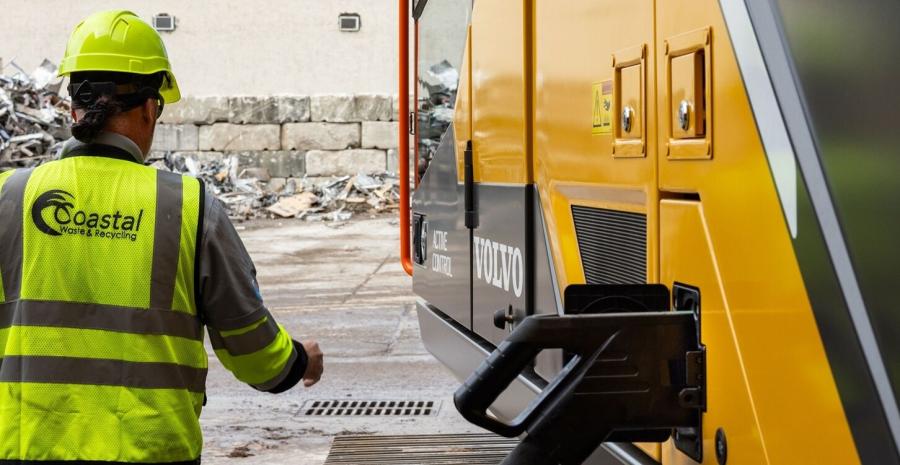
Photo courtesy of Volvo
Coastal Waste & Recycling is using the Volvo EC230 Electric excavator to process material for up to eight hours a day at a facility in Florida.
For more than a decade, the Advanced Clean Transportation (ACT) Expo has been the place to see and learn about the latest technologies, services and vehicles driving the transition to low- and zero-emission transportation solutions.
The show is largely focused on the on-road segment, so Volvo Trucks and Volvo Penta have participated for years. But lately, Volvo Construction Equipment has grown its presence alongside its Volvo Group colleagues to demonstrate innovations in off-road transformation as well.
At last year’s ACT Expo, Volvo CE announced it was bringing its EC230 Electric excavator to North America for pilot testing. At this year’s show in Las Vegas, the Volvo CE team shared results from those pilot projects, announced that the EC230 Electric is now commercially available in North America and introduced two new charging units.
“It’s an exciting time in the off-road segment as this transformation starts to gain traction,” said Ray Gallant, vice president — sustainability and productivity services at Volvo CE. “Collaborating with our on-road focused colleagues has helped us accelerate the transition in thoughtful and significant ways.”
The 23-ton EC230 Electric excavator represents a step up in size for electric heavy equipment, with most machines on the market today being compact models. Results from the pilot tests include:
Reduced emissions and production costs — Construction giant Skanska used the EC230 Electric to load trucks of export material from an underground tunnel as part of a transit line renovation in Los Angeles. The machine successfully reduced hourly carbon emissions by 66 percent and hourly costs by 74 percent over the 90-day test.
“The cost savings are just as important because if these solutions don’t make financial sense in addition to the emissions reduction, adoption will lag,” Gallant said.
In another 90-day pilot in California, this time collaborating with Sunbelt Rentals, the electric excavator delivered an 80 percent carbon reduction rate and 83 percent cost savings in comparison to its diesel equivalent.
“This project demonstrated that, even though production of the machine has a higher carbon footprint in comparison to its diesel equivalent, the fuel savings and carbon reduction offset that in just over 800 hours of use,” said Gallant.
Strong performance and uptime — In Florida, Coastal Waste & Recycling is using the EC230 Electric to process up to 100 tons of construction and demolition debris and green waste each hour. They use the machine for a partial shift, give it a quick charge and then use it on another shift, allowing them to get eight hours of work from the machine each day. Operators said it performs just as well as its diesel equivalent.
The possibility of entirely fossil-free fleets and job sites — On a job site in Stockholm City, Sweden, the EC230 Electric contributed to the reduction of 1,808 tons of carbon emissions, which is approximately what 180 Swedish people produce in one year. Electric equipment accounted for 23 percent of the site’s carbon reduction, while 46 percent was made possible by the use of hydrotreated vegetable oil (HVO100) for fuel and the rest was accomplished by reducing transport and reusing materials.
At Emterra Group in Vancouver, BC, the electric excavator is working as a support machine, consolidating waste in transfer stations that wheel loaders then load into trucks to haul away. The team’s hope is to transition to more electric machines that can handle the tough work of maximizing payloads and cycle times while reducing or eliminating emissions. Their general manager says the potential for replacing an entire fleet for carbon neutrality is very exciting.
A Revolution Has Begun
During a press event at ACT Expo, Gallant spoke about the three steps needed to transform a market with a new innovation. The first is proving its performance, like the recent EC230 Electric pilot tests and the years of results from Volvo CE compact electric machines.
The second step is to ensure the support infrastructure is in place. To demonstrate progress on that, Volvo CE announced two new partnerships on charging products. These were with Portable Electric for a Level 2 portable charging unit for compact equipment and Utility Innovation Group (UIG) for high-power DC portable charging. Those units were on display at the show along with the EC230 Electric, an EC18 Electric compact excavator and additional charging solutions.
And the third step, according to Gallant, is to learn and develop applications where battery-electric machines are a better fit than internal combustion units due to their unique features.
“The most prominent benefits of electric machines are the elimination of emissions and the significant reduction in noise and vibration,” he said. “We are seeing this equipment do well in a wide variety of applications where these benefits are really appreciated. Early adopters have brought us many unique opportunities and solutions.”
Beyond traditional construction applications, Volvo compact electric machines have been used in indoor demolition, agricultural and food production settings, landscaping, zoos, wineries, ski resorts and more.
Appearing at the show alongside Volvo Group counterparts and charging solution partners made it clear that Volvo CE will maintain a strong emphasis on collaboration to advance the zero-emission transformation.
“We know that the transportation sector understands the vision for electrification, which makes this show a great place to get the word out about other industries that can benefit from the same technologies,” said Gallant. “The only way we will reach these goals is by working together.”
For more information, visit volvoce.com.
